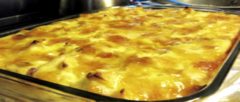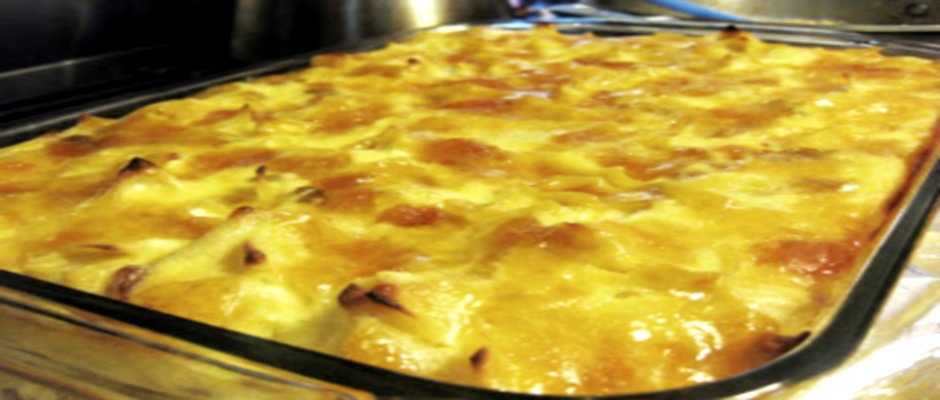I’ve been trying to pare down my cookbook collection, but couldn’t resist buying a copy of Crazy Good Kugel on a recent visit to Kahal Kadosh Beth Elohim, a historic synagogue in Charleston, South Carolina.
The slim, coil-bound volume comprises 32 recipes for sweet and savory kugels – the entries in the congregation’s “Great KKBE Kugel Cook-off.”
Confession: Even though my background is Ashkenazi Jewish, I rarely make kugel, the Ashkenazi Jewish pudding that typically has noodles or potatoes as a base.

Confession #2: I bought the cookbook for one recipe, and it wasn’t even one of the cook-off winners.
I was excited to find a recipe for Leftover Challah Pudding (Kugel), because – with half a cup of bourbon listed as one of the ingredients – it signified to me a compelling blend of Southern cooking and Jewish food.
What a great memento of the trip!
Lately, in part because I began blogging about food earlier this year, I’ve been thinking about the role Jewish food plays in my life.
One of the most-viewed entries on my blog was a reminiscence about my grandmother’s camisbroit (roly-poly), which I make once a year for the Jewish holidays. Preparing the recipe makes the holidays special for me, providing a tangible connection to my childhood.
I look forward to Jewish holidays in large part because of the food – homemade challah for Rosh Hashanah and Yom Kippur, potato latkes for Chanukah, and hamentashen for Purim.
I prepared those recipes with my children when they were growing up, and it was a fun time to bond and be creative. Over the years, we devised a variety of tasty concoctions for hamantashen fillings. Our two favorites are chocolate and a mix of ground walnuts, honey and cinnamon.
The food I prepare on a day-to-day basis is “Jewish” because there is no shellfish or non-kosher meat in my home, and I have separate dishes and utensils for meat and dairy. But I rarely make meat – partly because my daughter is vegetarian – so Ashkenazi staples like chicken soup and brisket have not been staples for me. I’m also lactose-intolerant, so cheese blintzes appear on my table infrequently.

Passover, the eight-day holiday with a whole extra layer of food restrictions, is in a category of its own. Because our diet has never been heavy on meat, and because I was usually a guest, not a host, at most of the annual Seders, we never bothered having meat at home during the holiday.
For several years, though, I hosted non-meat, non-dairy Seders, and I don’t believe anyone went home hungry. Personally, I prefer a lighter, alternative menu. Instead of brisket, chicken and/or turkey for the main course, I served baked salmon, but there were also many traditional foods on my table.
My soup (the Vegetarian “Chicken” Broth in Norene Gilletz’s MealLeaniYumm!) was filled with homemade matzo balls, and egg noodles the way my grandmother made them – crepes made of eggs and potato starch, rolled and sliced.
We would start our meal with gefilte fish, and the main course was rounded out with a variety of kugels, steamed asparagus, and tzimmes, a honey-sweetened blend of carrots, dried fruit and pineapple. My cousin advised me to add matzo ball mix, with an extra quarter cup of water, to make a knaidl in the middle of the tzimmes.
Dessert consisted of fruit and a variety of baked goods, including homemade macaroons and frozen strawberry mousse, which seems to be a standard at many Seders. When I was growing up, my grandmother would serve an unfrozen version over sponge cake.
It has occurred to me that, on a broader scale, Jewish food plays some of the same roles as a Jewish newspaper – reflecting a multifaceted Jewish population, and serving as a connection among different segments of the community, as well as to previous generations.
It can also facilitate connections outside the Jewish community. After my son and daughter entered university, their friends began to invite them to ethnic potlucks, and asked them to bring a Jewish dish. Both of them chose to make kugels, consulting with their grandmothers for advice and recipes.
But those recipes never had bourbon.
Frances Kraft was a reporter at The Canadian Jewish News for 22 years. She blogs at franceskraft.wordpress.com.
